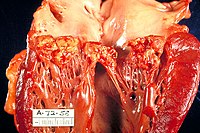
Photo from wikipedia
BACKGROUND Lead-related infective endocarditis (LRIE) is a serious infectious disease with uncertain prognosis. OBJECTIVE The purpose of this study was to evaluate the factors that influence survival in patients with… Click to show full abstract
BACKGROUND Lead-related infective endocarditis (LRIE) is a serious infectious disease with uncertain prognosis. OBJECTIVE The purpose of this study was to evaluate the factors that influence survival in patients with LRIE undergoing transvenous lead extraction (TLE). METHODS Clinical data obtained from 500 consecutive patients with LRIE undergoing TLE in the reference center in the years 2006 to 2015 were retrospectively analyzed. We evaluated the effect of demographic, clinical, and procedure-related factors on 30-day and long-term survival (mean 3-year follow-up). RESULTS Analysis of 30-day survival after TLE revealed 19 deaths (3.8%), with long-term mortality (mean 3-year follow-up) of 29.3% (146 deaths). Multivariate analysis showed unfavorable effects of age (hazard ratio [HR] 1.056, 95% confidence interval [CI] 1.030-1.082); decreased left ventricular ejection fraction (HR 0.687, 95% CI 0.545-0.866); renal failure (HR 3.099, 95% CI 1.865-5.150); and presence of vegetation fragments remaining after TLE (HR 1.384, 95% CI 1.089-1.760). Log-rank test and Kaplan-Meier survival curves demonstrated statistically worse prognosis in patients with large vegetations (>2 cm) and with vegetation remnants. Better prognosis was associated with LRIE coexisting with generator pocket infection. CONCLUSION Long-term mortality in LRIE patients is still high. Factors that influence negatively on prognosis include large cardiac vegetations and their remnants after TLE. Such vegetations develop most frequently in patients with decreased left ventricular ejection fraction and renal failure. Probably, early detection of LRIE would tend to limit the formation of large vegetations that invade the adjacent cardiac structures.
Journal Title: Heart rhythm
Year Published: 2017
Link to full text (if available)
Share on Social Media: Sign Up to like & get
recommendations!